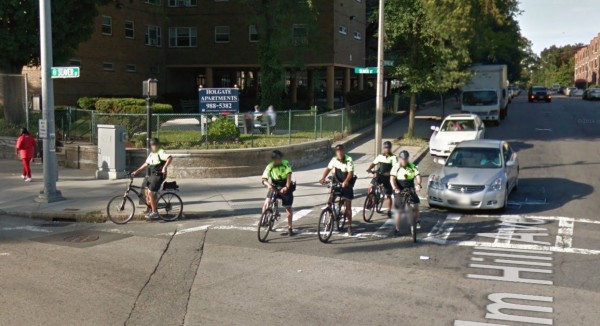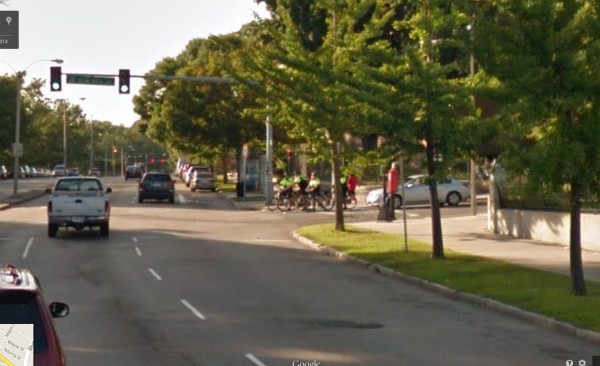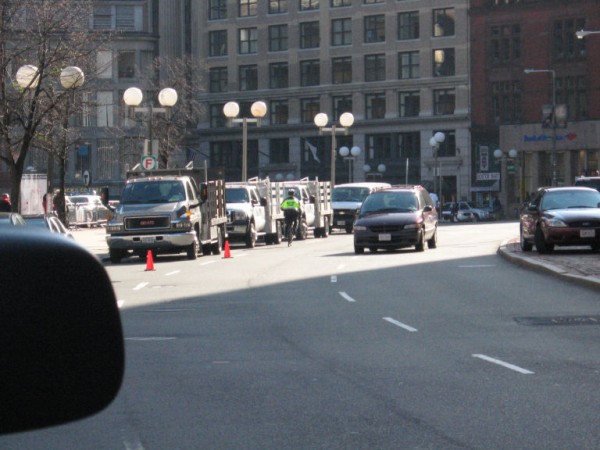Are the Boston Police getting the training they need to be safe and effective on bicycles?
I don’t think so. I don’t know how they train, but I have seen how they perform.
In another post, I described how a participant in a protest march pushed a Boston bicycle patrol officer over — intentionally or not, it isn’t clear. Evidently, the officers’ task was to prevent the march from spilling out from the street onto the sidewalks. The officer who fell — and others on both sides of the phalanx of marchers — were astride their bicycles, as shown also in the photo below. For crowd control, officers should stand with the bicycles between them and the crowd.
Some of the officers in the photos have their feet up on the curb. They are sitting on the saddle, not compatible with the best astride-the-bike stopping and restarting technique. The video below shows officers’ awkwardness in basic mounting and dismounting.
Correct starting and stopping techniques are described on this Web page. The video below shows the astride-the-bike technique.
A police officer from another city describes the techniques taught in International Police Mountain Bike Association training courses:
Disengage pedal from your retention. Swing the drivetrain (right) leg across, stand on the left pedal with the left foot, the right foot tucks behind the left at the ankle. You can now coast for a ways or step forward off the bike onto the ground (right foot first) and away from the bike – that is a dismount and exit. It is simple and works whether going fast or slower, in tactical situations, suspect contacts, or normal stops. With practice the rider can use their right foot to lower and engage a rear-mounted kickstand, mounted on the rear stays instead of behind the bottom bracket. With the kickstand down, the rider can walk away from the bike leaving it upright on the stand.
Looking at the videos again it seems they had an assortment of pedal retention, but it appears a number have none at all. That makes mounts, dismounts, and starts even easier to learn and perform, but more dangerous over obstacles where pedal retention helps hold the foot securely on the pedal.
For a simple stop, swing across to the left side, stand on the left pedal and put the right foot onto the ground either in front or behind the pedal – both work. The balance needs to be centered and care used on the front brake. An endo is still possible in that position. Officers are not encouraged to stop with the bike between their legs when dealing with a suspect or an unknown person. You can’t fight or react with a bike between your legs. It is obviously seen as okay at a stop sign, traffic signal, etc. They are encouraged to move forward off the saddle, having downshifted, and put their bike into a power pedal position. We also teach a power slide to dismount. EMS mostly uses road style techniques due to the balance they have with heavily loaded bags.
For starts we teach the technique you call the cowboy – also the road start where they swing over and straddle the bike, put bike into the power pedal and pedal away, and a modified cycle-cross. Push the bike forward, jump across the saddle and land on the saddle, perhaps not centered, power the first pedal that reaches your feet. I don’t know that we address the issue of starting on an incline unless a student brings it up. We require use of some sort of pedal retention, so that becomes in an issue early in class. Most use toe clips with straps or strapless toe clips.
There’s also the image below — found during an unrelated Google Maps expedition. Boston Police wait at a traffic light to cross into Franklin Park to go on patrol. The officers all have a foot on the low pedal, ready only for a shuffle start, not a power pedal start. An orderly and lawful stop behind the stop line and a brisk restart would have been more appropriate, more polite for the pedestrian and motorist in the photo, and a better example to citizens who ride bicycles.
Here’s a Google Maps image from a few seconds earlier, showing that the pedestrian had to walk behind the group of police officers who had stopped in the crosswalk.
Boston police also ride opposite the flow of traffic, for no evident reason, and violate the traffic law in other ways. The photo is from Congress Street, downtown Boston, November 18, 2009, 12:30 PM. I observed the officer riding a whole block opposite traffic.
There’s another example of a Boston police officer riding opposite traffic, with additional comments, on another page.
At the very least, what I have observed does not conform to best bicycling practice, or to good police practice. And it matters, for the sake of the officers’ safety and the effectiveness of their mission.





